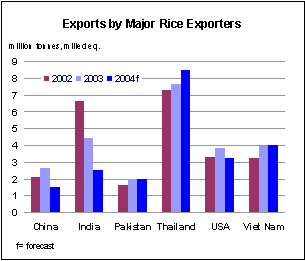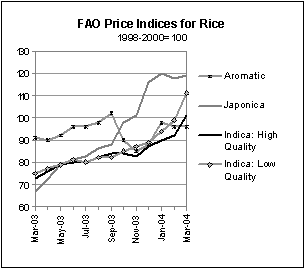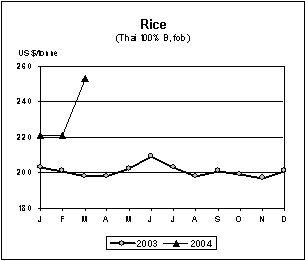


 |
 |
|
 |
||
|
|
||
|
|
|
| food outlook | |
| No. 1 | Rome, April 2004 |
|
RicePaddy production in 2004 tentatively set to grow by 3 percent FAO first forecast of paddy production in 2004 shows a 4 percent increase from the previous season, to 613 million tonnes, which would be the highest level on record. The forecast is still highly tentative, since the season in the major producing countries situated in the northern hemisphere will not commence until mid-year. Rice Production
Source: FAO. Note: Totals computed from unrounded data.
1/ Including Taiwan Province
However, initial results from on-going harvests in countries in the southern hemisphere already point to a 3 million tonne increase from the previous season, to 81 million tonnes. Along and south of the equator, prospects are positive so far in Indonesia as well as Malaysia where some 400 000 hectares of new land have been opened for rice cultivation. By contrast, drought at planting time has limited the production potential in Sri Lanka. In Africa, the season is well advanced in Madagascar, Mozambique and Tanzania. In Madagascar, production might fall this year, reflecting a poor start of the season and the impact of two cyclones that hit the country at a critical stage of crop development. A recovery from last year’s shortfall is anticipated in Tanzania. High prices last year bolstered plantings in most of South America. Favourable growing conditions have further boosted the outlook for Argentina, Brazil and Uruguay. By contrast, drought conditions are expected to impair production in Ecuador and Peru. Low water allocations to producers in Australia constrained plantings again this year, but were sufficient to sustain a 54 percent increase in production from the dismal outcome of last season. The early forecasts of 2004 paddy production in northern hemisphere countries are mainly based on the prevailing government policies, expectations of favourable producer prices and “normal” growing conditions. In Asia, China and India are expected to account for much of the anticipated increase in world output. In the first country, rising domestic prices have raised concern of an imminent tightness, which has prompted the government to launch several initiatives to boost production. Sizeable production gains are anticipated in Bangladesh, Indonesia, Philippines and the Islamic Republic of Iran, consistent with the expansionary policies pursued by those countries. Production should recover in Japan and the Republic of Korea where adverse weather conditions hampered crops last season. Strong price incentives should also boost the sector in Thailand and Pakistan. By contrast, Viet Nam has set a smaller production target this season, reflecting a 10 percent loss of its winter-spring crop because of drought. In Myanmar, the disruption caused by sudden changes in policies and the resulting slump in domestic prices are also anticipated to depress output. Production in Africa is set to grow modestly, although government efforts to promote the sector could give rise to some increases in Ghana, Mali and Nigeria. High prices should also sustain growth in Egypt. In Central America and the Caribbean, increases are anticipated in Mexico, supported by the introduction of new programmes to guarantee a minimum income to producers. High import prices should also boost output in Costa Rica, Nicaragua and Panama. In the rest of the world, the United States has forecast a record output in 2004, since producers are expected to respond to high prices by increasing plantings. Little change in production is currently foreseen for the EU, although the implementation of the new policy regime as of September, introduces some elements of uncertainty.
 A sharp contraction in international trade in rice expected in 2004 FAO’s forecast of world trade in rice in 2004, which is largely determined by the outcome of production in 2003, has been reduced by some 0.8 million tonnes from the previous report to some 25.5 million tonnes, which is 2.5 million tonnes lower than the estimate for 2003. The lowering of the 2004 forecast mainly reflects a worsening of export prospects for China and India, which more than offset some upward revisions for Thailand, Cambodia, Egypt, the United States and Uruguay. According to the present outlook, China is anticipated to export 1.5 million tonnes during 2004, down from 2.6 million tonnes last year. In recent months the country has witnessed sharp increases in market prices that are likely to prompt the government, which holds a monopoly on rice exports, to restrict sales abroad. In India, steps have already been taken by the Food Corporation of India (FCI) to temporarily suspend sales for exports, pending an assessment of FCI buffer stocks, which were heavily depleted in the past two years. The ban coincided with the passing of new regulations, which will allow exporters to purchase rice directly from farmers rather than exclusively through the FCI. Sales from the country are currently prospected to hover around 2.5 million tonnes, down from 4.4 million tonnes in 2003. In January, Myanmar also prohibited exports for six months. As a result, the country’s exports are forecast at 500 000 tonnes, little changed from last year but well below the country’s potential. United States’ shipments are expected to drop from 3.8 million tonnes to 3.2 million tonnes, constrained by high domestic prices and falling availabilities. Limited supply should also restrain sales from Australia to 200 000 tonnes, or about one-third of “normal” levels. Similarly, exports from Japan and the Republic of Korea, most of which are made in the form of food aid, are anticipated to be smaller following last season’s production shortfalls and dwindling stocks. By contrast, shipments from Pakistan should remain of the order of 2 million tonnes, especially if the government maintains transportation subsidies, while sales by Thailand and Viet Nam, the two major rice exporters, are officially foreseen to increase to 8.5 million tonnes and 4.0 million tonnes, respectively. Viet Nam’s export performance, however, will depend critically on the size of the winter/spring crop currently at the harvest stage. Scarcity of supplies already prompted the Government to advise exporters to refrain from signing new contracts requiring deliveries before the next harvest in June. In the rest of the world, favourable crops and higher international prices should boost shipments by Argentina, Uruguay and Egypt. The reduction in the 2004 global import forecast reflects a number of adjustments that take into account the prospects of higher prices and freight rates and the reduced availabilities in China and India. For instance, the forecast of aggregate imports by African countries, part of which were sourced in those two countries, has been cut. At the same time, the forecast of imports by China was raised, following news of an intensification of trans-border movements of rice into the country. Compared with 2003, imports by Asian countries are now anticipated to fall, mainly on account of weaker demand by Bangladesh and the Philippines following excellent harvests in 2003, and by Indonesia, where imports have been banned from 20 January to 30 June. Despite the recent announcement of the liberalization of rice imports by the Islamic Republic of Iran, the imposition of high tariffs (100 percent ad-valorem tariff plus a discretionary duty of some US$190 per tonne this year) and improved domestic availability should also result in reduced shipments to the country. Smaller flows of food aid are likely to cut overall rice deliveries to the Democratic Republic of Korea. By contrast, Iraq, where the control over food grain procurement passed from the World Food Programme to the country’s Ministry of Trade in April, is anticipated to import 1 million tonnes, up from 700 000 tonnes last year. China (mainland) is foreseen to purchase about 1.2 million tonnes, the highest level since 1995. In Africa, overall rice imports are likely to fall again this year, especially if world prices and freight rates keep rising, with the Cote d’Ivoire, Nigeria and Senegal accounting for much of the contraction. However, deliveries to Ghana and Madagascar are forecast to increase, to compensate for the latest season production shortfalls. In Latin America and the Caribbean, Brazil cut the official import forecast to 550 000 tonnes, down from over 1 million tonnes in 2003, in anticipation of a good 2004 paddy harvest. However, deliveries to both the Dominican Republic and Peru are foreseen to increase substantially, to compensate for smaller domestic supplies. Among the other major rice markets, deliveries to the United States are anticipated to be larger, attracted by high domestic prices. The Russian Federation is also foreseen to step up its purchases, especially since, unless extended, the 10 percent tariff would no longer be subject to a minimum value of €30 per tonne as of 20 March. Imports to the EU are provisionally forecast to remain of the order of 700 000 tonnes, although the halving of intervention prices as of September 2004 might result in much lower variable import duties. Overall rice consumption stable in 2004 World rice utilization is forecast to reach some 415 million tonnes, in milled equivalent, little changed from the previous year. Most will be used for human consumption, with food utilization estimated to fluctuate around 368 million tonnes. On a per capita basis, rice food consumption is forecast at 58.6 kg in 2004, down slightly from 58.7 kg last year. Consumers are likely to face price rises this year, which will be compounded in the major importing countries by sharp increases in freight rates. Global carry over stocks to fall for the fourth consecutive year Since global rice utilization is again anticipated to outstrip production, global rice stocks are forecast to fall to 102 million tonnes at the close of the marketing season ending in 2004, down from 120 million tonnes a season earlier. As in the previous years, China is likely to account for much of the contraction, as the country end-of-season inventories could shrink from 78 million tonnes to 62 million tonnes. Among major exporters, a decline is anticipated in Australia, Egypt, Thailand and the United States. Rice reserves should also diminish in some major importing countries, including the Islamic Republic of Iran and the Philippines, in part due to reduced imports prospects, as well as in Japan, the Republic of Korea, following last season production shortfalls. By contrast, carry-over stocks might increase somewhat in India, though remaining well below historical levels, and in Myanmar, but would change little in Viet Nam. International rice prices to keep rising  Rice prices recovered strongly over most of 2003, as reflected in the FAO all Rice Price Index (1998-2000=100) which averaged 82 for the whole year, up from 72 in 2002. The strength persisted in the first few months of 2004 as supplies tightened in major exporting countries. In March 2004, the index reached 109, the highest level since February 1999, and 20 points above the value in October. Although the past five months coincided with the harvesting of the main paddy crops in major exporting countries, prices of all the various types and qualities of rice have followed a rising trend since October. For instance, within the high quality Indica rice segment, the price of Thai 100%B rice rose from US$199 per tonne last October to US$253 per tonne in March, with an even stronger increase reported for rice from Pakistan. As for the lower quality Indica, the Thai A1 Super quotations passed from US$158 to US$213 over the period, sustained by the withdrawal of Myanmar and Indian exporters from the market. Particularly strong price increases also affected medium grain rice, with the Japonica rice price sub- index surging 21 points between October and March. The rise was less pronounced for aromatic rice prices, the index of which rose by 6 points in the same period.  International rice prices are expected to increase further in the coming months, especially if China, which will not harvest its early rice crop before June, intensifies its purchases. However, the pressure would be mitigated, should Myanmar or India lift their restrictions on rice exports. |
||||||||||||||||||||||||||||||||||||||||||||||||||||||||||||||||||||||||||||||||||||||||||||||||||||||||||||||||||||||||||||||||||||||||||||||||||||||||||||||||||||||||||||||||||||||||||||